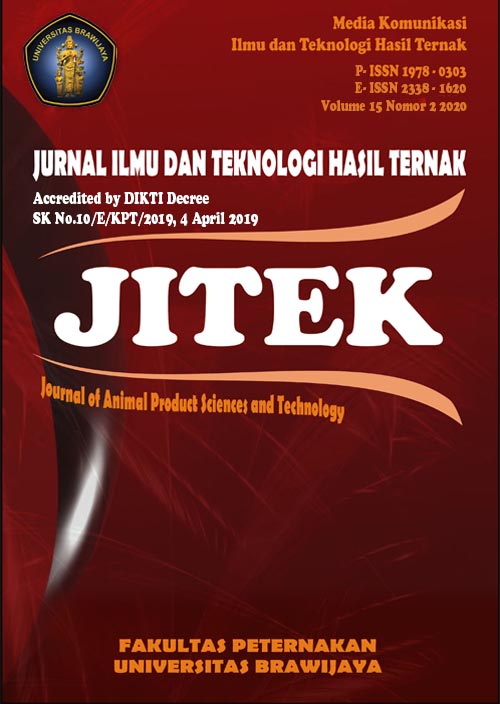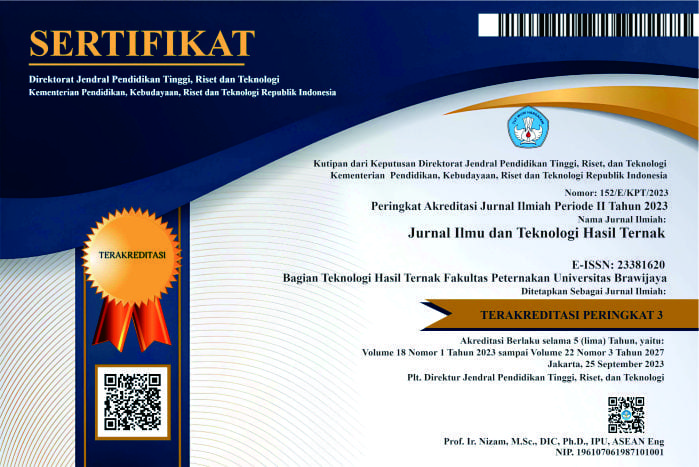Aqueous Leaf Extract of Senduduk (Melastoma malabathricum L.) Could Improve the Physicochemical Properties of Beef Sausage Dough
DOI:
https://doi.org/10.21776/ub.jitek.2020.015.02.4Keywords:
Antioxidant, nitrite replacement, Melastoma malabathricum, physicochemical, sausageAbstract
Improving comminuted meat products characteristics using a natural agent, such as phytochemicals, in order to replace the use of nitrite, have become a need due to the health reason. The quality of the sausage is also affected by the initial characteristics of the dough. Therefore, this research was conducted to investigate the effect of aqueous leaf extract of senduduk (Melastoma malabathricum L.) on the physicochemical properties of beef sausage dough. Different four formulas as treatment were employed to form the dough: formula A was as a control consisted of beef meat, vegetable oil, skim milk powder, tapioca, salt, phosphate, and seasoning; formula B was control added with extract 0.55%; formula C was control added with sodium nitrite 0.0011%, and formula D was control added with extract 0.55% and sodium nitrite 0.0011%. All ingredients were blended to be the dough. The result of the study denoted that the extract (B and D) significantly decreased (P<0.05) pH, and aw value with no difference in water content among the dough. The total phenolic content of the dough containing extract (B and D) was markedly higher (P<0.05) than were others. It increased significantly on antioxidant capacity, scavenging activity, and reduced the thiobarbituric acid reactive substances (TBARS) value of the dough. There was also no nitrite residual detected in all dough. In conclusion, the extract could improve the physicochemical properties of beef sausage dough and replace the use of nitrite in the dough.References
Al-Saeedi, A. H., & Hossain, M. A. (2015). Total phenols, total flavonoids contents and free radical scavenging activity of seeds crude extracts of pigeon pea traditionally used in Oman for the treatment of several chronic diseases. Asian Pacific Journal of Tropical Disease, 5(4), 316–321. https://doi.org/10.1016/S2222-1808(14)60790-8
Alnajar, Z. A. A., Abdulla, M. A., Ali, H. M., Alshawsh, M. A., & Hadi, A. H. A. (2012). Acute Toxicity evaluation, antibacterial, antioxidant and immunomodulatory effects of melastoma malabathricum. Molecules, 17(3), 3547–3559. https://doi.org/10.3390/molecules17033547
Alwash, M. S. A., Ibrahim, N., Yaacob, W. A., & Din, L. Bin. (2014). Antibacterial, antioxidant and cytotoxicity properties of traditionally used Melastoma malabathricum Linn. leaves. Advance Journal of Food Science and Technology, 6(1), 6–12.
Andarwulan, N., & Faradilla, R. F. (2012). Senyawa Fenolik pada Beberapa Sayuran Indigenous dan Indonesia. SEAFAST Center IPB.
Anggraini, T. (2017). Antioxidant activity of Syzygium oleana. Pakistan Journal of Nutrition, 16(8), 605–611. https://doi.org/10.3923/pjn.2017.605.611
Anyanwu, S., Inyang, I. J., Asemota, E. A., Obioma, O. O., Okpokam, D. C., & Agu, V. O. (2017). Effect of ethanolic extract of Chromolaena odorata on the kidneys and intestines of healthy albino rats. Integrative Medicine Research, 6(3), 292–299. https://doi.org/10.1016/j.imr.2017.06.004
AOAC (Association of Official Analytical Chemist). (2005). Association of Official Agricultural Chemists Official methods of analysis of AOAC International (18th ed.). AOAC.
Bendary, E., Francis, R. R., Ali, H. M. G., Sarwat, M. I., & El Hady, S. (2013). Antioxidant and structure–activity relationships (SARs) of some phenolic and anilines compounds. Annals of Agricultural Sciences, 58(2), 173–181. https://doi.org/10.1016/j.aoas.2013.07.002
BPOM. (2019). Peraturan Badan Pengawas Obat dan Makanan No 11 Tahun 2019 Tentang Bahan Tambahan Pangan. Badan Pengawas Obat dan Makanan.
De Mey, E., De Klerck, K., De Maere, H., Dewulf, L., Derdelinckx, G., Peeters, M.-C., Fraeye, I., Vander Heyden, Y., & Paelinck, H. (2014). The occurrence of N-nitrosamines, residual nitrite and biogenic amines in commercial dry fermented sausages and evaluation of their occasional relation. Meat Science, 96(2), 821–828. https://doi.org/10.1016/j.meatsci.2013.09.010
Devatkal, S. K., Narsaiah, K., & Borah, A. (2010). Anti-oxidant effect of extracts of kinnow rind, pomegranate rind and seed powders in cooked goat meat patties. Meat Science, 85(1), 155–159. https://doi.org/10.1016/j.meatsci.2009.12.019
Doughari, J. H., & Manzara, S. (2008). In vitro antibacterial activity of crude leaf extracts of Mangifera indica Linn. African Journal of Microbiology Research, 4(22), 67–72. https://doi. org/10.5897/AJMR
Herrmann, S. S., Duedahl-Olesen, L., & Granby, K. (2015). Occurrence of volatile and non-volatile N-nitrosamines in processed meat products and the role of heat treatment. Food Control, 48, 163–169. https://doi.org/10.1016/j.foodcont.2014.05.030
Honikel, K.-O. (2008). The use and control of nitrate and nitrite for the processing of meat products. Meat Science, 78(1), 68–76. https://doi.org/10.1016/j.meatsci.2007.05.030
Insausti, K., Beriain, M., Purroy, A., Alberti, P., Gorraiz, C., & Alzueta, M. (2001). Shelf life of beef from local Spanish cattle breeds stored under modified atmosphere. Meat Science, 57(3), 273–281. https://doi.org/10.1016/S0309-1740(00)00102-9
Ji, L., Qian, C., Liu, M., & Chen, X. (2011). Highly efficient nitration of phenolic compounds using some nitrates and oxalic acid under solvent-free conditions. Journal of Chemical Research, 35(2), 101–103. https://doi.org/10.3184/030823411X12935549795603
Jung, E., & Joo, N. (2013). Roselle (Hibiscus sabdariffa L.) and soybean oil effects on quality characteristics of pork patties studied by response surface methodology. Meat Science, 94(3), 391–401. https://doi.org/10.1016/j.meatsci.2013.02.008
Kamsani, N. E., Zakaria, Z. A., Md Nasir, N. L., Mohtarrudin, N., & Mohamad Alitheen, N. B. (2019). Safety assessment of methanol extract of Melastoma malabathricum L. leaves following the subacute and subchronic oral consumptions in rats and its cytotoxic effect against the HT29 cancer cell line. Evidence-Based Complementary and Alternative Medicine, 2019, 1–14. https://doi.org/10.1155/2019/5207958
Karwowska, M., Kononiuk, A., & Wójciak, K. M. (2019). Impact of sodium nitrite reduction on lipid oxidation and antioxidant properties of cooked meat products. Antioxidants, 9(1), 9. https://doi.org/10.3390/antiox9010009
Lorenzo, J. M., Sineiro, J., Amado, I. R., & Franco, D. (2014). Influence of natural extracts on the shelf life of modified atmosphere-packaged pork patties. Meat Science, 96(1), 526–534. https://doi.org/10.1016/j.meatsci.2013.08.007
Mahmoudi, S., Khali, M., Benkhaled, A., Benamirouche, K., & Baiti, I. (2016). Phenolic and flavonoid contents, antioxidant and antimicrobial activities of leaf extracts from ten Algerian Ficus carica L. varieties. Asian Pacific Journal of Tropical Biomedicine, 6(3), 239–245. https://doi.org/10.1016/j.apjtb.2015.12.010
Mariem, C., Sameh, M., Nadhem, S., Soumaya, Z., Najiba, Z., & Raoudha, E. G. (2014). Antioxidant and antimicrobial properties of the extracts from Nitraria retusa fruits and their applications to meat product preservation. Industrial Crops and Products, 55, 295–303. https://doi.org/10.1016/j.indcrop.2014.01.036
Mason, S. L., Loughran, Ö., & La Thangue, N. B. (2002). Nitrosation of phenolic compounds: Effects of alkyl substituents and solvent. Monatshefte Fur Chemie, 133(2), 157–166. https://doi.org/10.1007/s706-002-8245-0
Nurdiana, S., & Marziana, N. (2013). Wound healing activities of Melastoma malabathricum leaves extract in Sprague dawley rats. International Journal of Pharmaceutical Sciences Review and Research, 20(2), 20–23.
Patel, R. (2000). Mechanisms of the pro- and anti-oxidant actions of nitric oxide in atherosclerosis. Cardiovascular Research, 47(3), 465–474. https://doi.org/10.1016/S0008-6363(00)00086-9
Pereira, D. M., Valentão, P., Pereira, J. A., & Andrade, P. B. (2009). Phenolics: From chemistry to biology. Molecules, 14(6), 2202–2211.
Shalaby, A. (2013). Antioxidant compounds, assays of determination and mode of action. African Journal of Pharmacy and Pharmacology, 7(10), 528–539. https://doi.org/10.5897/AJPP2013.3474
Suharyanto, Nuraini, H., Suryati, T., Arief, I. I., & Sajuthi, D. (2019). Antioxidant and antibacterial properties of aqueous extract of senduduk (Melastoma malabathricum L.) leaf from Indonesia for food additive. Pakistan Journal of Nutrition, 18(4), 391–400. https://doi.org/10.3923/pjn.2019.391.400
Sukisman, Purnomo, H., Rosyidi, D., & Eka Radiat, L. (2014). Quality properties, antioxidant capacity and total phenolic content of traditional deep fried shredded meat (abon) of Palu, Central Sulawesi. American Journal of Food Technology, 9(2), 80–88. https://doi.org/10.3923/ajft.2014.80.88
Suryati, T., Astawan, M., Lioe, H. N., Wresdiyati, T., & Usmiati, S. (2014). Nitrite residue and malonaldehyde reduction in dendeng — Indonesian dried meat — influenced by spices, curing methods and precooking preparation. Meat Science, 96(3), 1403–1408. https://doi.org/10.1016/j.meatsci.2013.11.023
Susanti, D., Sirat, H. M., Ahmad, F., Ali, R. M., Aimi, N., & Kitajima, M. (2008). Erratum to “Antioxidant and cytotoxic flavonoids from the flowers of Melastoma malabathricum L.â€. Food Chemistry, 107(3), 1275. https://doi.org/10.1016/j.foodchem.2007.09.009
Turgut, S. S., Soyer, A., & Işıkçı, F. (2016). Effect of pomegranate peel extract on lipid and protein oxidation in beef meatballs during refrigerated storage. Meat Science, 116, 126–132. https://doi.org/10.1016/j.meatsci.2016.02.011
Wang, Y., Li, F., Zhuang, H., Chen, X., Li, L., Qiao, W., & Zhang, J. (2015). Effects of plant polyphenols and α-tocopherol on lipid oxidation, residual nitrites, biogenic amines, and N-nitrosamines formation during ripening and storage of dry-cured bacon. LWT - Food Science and Technology, 60(1), 199–206. https://doi.org/10.1016/j.lwt.2014.09.022
Wong, K.-C., Hag Ali, D. M., & Boey, P.-L. (2012). Chemical constituents and antibacterial activity of Melastoma malabathricum L. Natural Product Research, 26(7), 609–618. https://doi.org/10.1080/14786419.2010.538395
Zakaria, Z. A., Rofiee, M. S., Mohamed, A. M., Teh, L. K., & Salleh, M. Z. (2011). In vitro antiproliferative and antioxidant activities and total phenolic contents of the extracts of Melastoma malabathricum leaves. Journal of Acupuncture and Meridian Studies, 4(4), 248–256. https://doi.org/10.1016/j.jams.2011.09.016
Zhu, Y., Wang, P. P., Zhao, J., Green, R., Sun, Z., Roebothan, B., Squires, J., Buehler, S., Dicks, E., Zhao, J., Cotterchio, M., Campbell, P. T., Jain, M., Parfrey, P. S., & Mclaughlin, J. R. (2014). Dietary N -nitroso compounds and risk of colorectal cancer: a case–control study in Newfoundland and Labrador and Ontario, Canada. British Journal of Nutrition, 111(6), 1109–1117. https://doi.org/10.1017/S0007114513003462
Zubillaga, M., Maerker, G., & Foglia, T. (1984). Antioxidant activity of sodium nitrite in meat. American Oil Chemists’ Society, 61(4), 772–776.
Downloads
Published
Issue
Section
License
Copyright (c) 2020 Suharyanto Suharyanto, Henny Nuraini, Tuti Suryati, Irma Isnafia Arief, Dondin Sajuthi

This work is licensed under a Creative Commons Attribution-NonCommercial 4.0 International License.
Authors who publish with this journal agree to the following terms:
- Authors retain copyright and grant the journal right of first publication with the work simultaneously licensed under a Creative Commons Attribution License that allows others to share the work with an acknowledgement of the work's authorship and initial publication in this journal.
- Authors are able to enter into separate, additional contractual arrangements for the non-exclusive distribution of the journal's published version of the work (e.g., post it to an institutional repository or publish it in a book), with an acknowledgement of its initial publication in this journal.
- Authors are permitted and encouraged to post their work online (e.g., in institutional repositories or on their website) prior to and during the submission process, as it can lead to productive exchanges, as well as earlier and greater citation of published work (See The Effect of Open Access).















